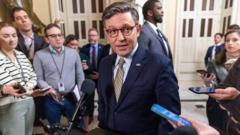The recent ceasefire between Israel and Hezbollah comes after a devastating series of attacks, prompting widespread evacuations. Despite the cessation of hostilities, Lebanon's future remains uncertain, with significant casualties, economic losses, and the potential for further internal conflict.
Uncertain Future for Hezbollah Following Ceasefire in Lebanon

Uncertain Future for Hezbollah Following Ceasefire in Lebanon
As a ceasefire between Israel and Hezbollah is announced, the aftermath raises complex questions about Hezbollah's future and Lebanon's stability.
The streets were dimly lit and filled with anxious residents carrying survival bags, uncertain of their next destination. This was the scene in Nuweiri, Beirut, as the Israeli military issued urgent evacuation warnings, the first for such central areas. Reports of explosions enveloped the city during what had become a chaotic night. Earlier that afternoon, an Israeli airstrike flattened a building in Nuweiri and claimed at least seven lives. Efforts to reach the site were thwarted by crowds and motorcycle riders warning of dangers ahead. Moments afterwards, the sounds of more bombings echoed through the air, alongside gunfire, as Israeli drones hovered ominously overhead.
This escalation coincides with heightened anticipation for a ceasefire agreement aimed at resolving over a year of conflict with Hezbollah, the influential Iranian-supported militia based in Lebanon. Following intense bombardment throughout Beirut, including an unprecedented strike on the southern suburbs, an official ceasefire has been declared. However, the damaging impact on Lebanon has been profound, with over 3,700 lives lost since October 2023 and one million people displaced from regions where Hezbollah wields considerable power. The World Bank estimates economic damages at around $8.5 billion, leaving the pathway for recovery uncertain.
The ceasefire arrangement entails the deployment of thousands of Lebanese soldiers to southern Lebanon following the withdrawal of Israeli and Hezbollah fighters. Yet, the logistics of this deployment remain ambiguous, with the Lebanese military voicing concerns regarding insufficient resources to effectively manage this responsibility. The dichotomy of funding sources suggests assistance from international allies; however, questions linger about the Lebanese military's willingness to confront Hezbollah, where sectarian divides are often fraught with tension.
Hezbollah, too, finds itself in a precarious state, having suffered significant losses, including vital leadership figures like Hassan Nasrallah and devastating damage to its infrastructure. The organization's future role in Lebanon is now debatable; though it remains intact as a political entity and social organization, its influence may be curtailed by its adversaries in light of its recent struggles.
The potential for internal strife increases as the country comes to terms with its complicated realities. While the ceasefire could halt external conflict with Israel, the specter of renewed internal discord looms large, as Lebanon grapples with the aftermath of war and the possible reshaping of its political landscape. The debate surrounding Hezbollah's influence and the broader implications for Lebanon's future continues to unfold amidst hopes for peace and stability.
This escalation coincides with heightened anticipation for a ceasefire agreement aimed at resolving over a year of conflict with Hezbollah, the influential Iranian-supported militia based in Lebanon. Following intense bombardment throughout Beirut, including an unprecedented strike on the southern suburbs, an official ceasefire has been declared. However, the damaging impact on Lebanon has been profound, with over 3,700 lives lost since October 2023 and one million people displaced from regions where Hezbollah wields considerable power. The World Bank estimates economic damages at around $8.5 billion, leaving the pathway for recovery uncertain.
The ceasefire arrangement entails the deployment of thousands of Lebanese soldiers to southern Lebanon following the withdrawal of Israeli and Hezbollah fighters. Yet, the logistics of this deployment remain ambiguous, with the Lebanese military voicing concerns regarding insufficient resources to effectively manage this responsibility. The dichotomy of funding sources suggests assistance from international allies; however, questions linger about the Lebanese military's willingness to confront Hezbollah, where sectarian divides are often fraught with tension.
Hezbollah, too, finds itself in a precarious state, having suffered significant losses, including vital leadership figures like Hassan Nasrallah and devastating damage to its infrastructure. The organization's future role in Lebanon is now debatable; though it remains intact as a political entity and social organization, its influence may be curtailed by its adversaries in light of its recent struggles.
The potential for internal strife increases as the country comes to terms with its complicated realities. While the ceasefire could halt external conflict with Israel, the specter of renewed internal discord looms large, as Lebanon grapples with the aftermath of war and the possible reshaping of its political landscape. The debate surrounding Hezbollah's influence and the broader implications for Lebanon's future continues to unfold amidst hopes for peace and stability.



















